Mind Streaming
John Coxon's Online Journal|
Archive Search |
| Links |
|
and s-integrator |
Saturday, June 07, 2003
CAPITAL WORDS
Friday, June 06, 2003
London's 'Cockney' Rhyming Slang
Your traditional 'cockney sparrow' ( sociable, garillous,cheeky, life-loving East-End Londoner) might very well utter an unusual slang English phrase or two that might baffle the uninitiated foreign visitor.
Like so many slangs, Cockney rhyming slang may well have developed originally as a district identifier but also as a deliberate disguise of what was actually being said, to outsiders. One view is that cockney rhyming slang developed in the London criminal underworld at the time when Robert Peel's new police force began to make an impact on crime and suggests that the slang was a way of keeping nafarious things secret. Others say it started with costermongers and street traders wanting to keep what they were saying from their customers.
I remember that 'back slang' was in common use in Borstals and 'Approved Schools' ( basically both then lock up prisons for young offenders) by young inmates hoping to be able to talk in a private language so that they couldn't be understood. You had to learn their slang to either teach or control such kids so you knew what they were up to or calling you.
It is quite difficult to describe Cockney Rhyming Slang and much easier to give a few common examples. Whilst, as you'd expect, the slang is alive and well in parts of the U.K. capital where it originated, some examples are familair to a broader area of Britain. "Dickie Bird" and "Donkey ears/years" seem common all over the island, for example as are "use your loaf" (think) have a "butchers"(take a look at)
Here are a few examples to demonstrate the way the slang works.
"I haven't seen you for donkeys" ( donkey's years = years)
"I'm on my pat tonight?" (Pat Malone = alone)
"Someone's on the dog for you" (Dog and bone = phone)
"I'm going to wear my whistle" (whistle and flute = suit)
"Just buried my trouble "(trouble and strife = wife)
"She fell down the apples" (apples and pears =stairs)
"Don?t say a Dickie" (Dickie Bird = word)
"Hello my old china" (China plate = mate/friend)
"Would you Adam and Eve it ?" (believe)
"Use your loaf" (loaf of bread = head)
"Let's have a butchers" (butcher's hook=look)Others include :-"Half-inch"=pinch(steal)
"Plates of meat" (feet)
"Rosie Lee" (tea)
Borrasic lint= skint (no money)
There are several on line searchable Cockney Rhyming Slang web sites and they seem to be a mixture of authentic traditional slang and new word inventions, (such as "Posh and Becks" , referring to 'Posh' Spice (Victoria Beckham)and David Beckham, and allegedly rhyming slang for decks (the kind DJ's use for playing vinyl records. ) Click on the word link for a sample rhyming slang dictionary website. Dictionary
Allied to this slang is the tradition of the Cockney Pearly Kings and Queens (traditional working class self-appointed, charity fund rising pearl button adorned street royalty.) A brief illustrated history can be found at Pearlies

Traditionally you can only be a 'true' cockney if you were born within the sound of the big bells of Bow ( the church of St.Mary le Bow in Cheapside, East London.) (Clearly, actor Dick van Dyke never came within a thousand miles of the bells when working on his part as the cockney chimney sweep in 'Mary Poppins.' The cockney defining church was designed and erected by Sir Christopher Wren just after the Great Fire of London(1666) The new building was built over the original Norman Church 'St Marie de Arcubus [ Le Bow] ( named, apparently, because of the bow-like shape of its original arches) and the new church retained that name since . (John Milton, was born near the church in Bread Street, a fact that is commemorated on an outside wall of the church . It was common in Milton's day that literary works were published from church yards in London's Fleet Street. 'Paradise Lost' was , for example, published from St. Dunstan's, Fleet Street.
There is, incidentally an awesome architecture web site at GREAT BUILDINGS with comprehensive details and high resolution images of some 800 of the world's most famous buildings ( including major ones in London) and includes hundreds of downloadable 3D buildings models.
johncoxon 11:13 PM - [Link] - Comments ()
...
TRUE TO TYPE ?
Thursday, June 05, 2003
What is the connection between,grapes (or olives), China, paper and lead ?
The answer is print and the invention of the printing press from which some words are still part of our everyday language, like the word 'font' for styles of lettering we chose when writing in word processing programs.
Western history tends to credit the German, Gutenberg as the 'father' of printing ; with the invention of the printing press and movable metal type. However the printing process ( using hand cut woodblocks) was, my Net-research reveals, first used during the Sui Dynasty in China. ( circa 581) Bi Sheng used, I learned, the less durable clay movable-type blocks for printing as early as 1041 and, apparently a system of printing from movable metal type was developed in Korea using Chinese characters a generation before Gutenberg. Yet Johannes couldn't, I'd guess, possibly have known about these developments, so perhaps he deserves the traditional credit he gets. Gutenberg's printing press was 'powered' by a modified wine press , (although some historians suggest he adapted an olive press.) The ecellent HOUSTON MUSEUM OF PRINTING has a fine, full-scale working replica of Gutenberg's original letter press.

Now I always thought that the material those hard-working early monks produced their wonderful illuminated manuscripts upon had a romantic sounding name until I discovered recently that vellum was made from lamb or calf skin. Vellum was widely used for books, pre-Gutenburg, partly because of its assured durability. Such books were the almost the exclusive domain of monk scibes, were religious in content, took often years to produce, and were very expensive. (For a very brief history of the book click on BOOK HISTORY With the advent of the Gutenberg's press coinciding with the ability to mass produce paper, the days of vellum as a medium were numbered.
Near my home, on the wall of what is now a thriving Stationers, is the fading evidence of a gentleman who ran a printing letter press works from the 1870's 
Quite a few companies traded under the name of the founder of English printing, Caxton.
William Caxton was the producer of the first printed book in England, his translation of The History of Troy (1473/4) and the first dated printed book in England his 'The dictes or sayengis of the philosophres' (1477) Click this word link for a detailed, illustrated history of his publications CAXTON I was reminded too, of William Caxton, during a visit to the fabulous Working Class Movement Library in Salford recently, ( Click here for a picture of what is a lovely building the museum is housed in WCML Building where, amongst so many beautifully ornate ,framed Trades Union membership certificates from the Victorian era, I photographed one relating to the Typographical Association, an early print union.. (The Typographical Association was established in 1849 Print Unions, are traditionally organised in 'Chapels' and their union officials are known as the 'Father's of the Chapel.' Click on this thumbnail for a larger section of this beautiful Union membership certificate,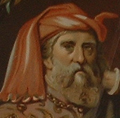
A recent visit to Manchester's magnificent SCIENCE & INDUSTRY MUSEUM , housed, incidentally in the huge, restored warehouses and related buildings of the London and Great Western Railway (and the site of the first ever railway service in Britain - Manchester to Liverpool) provided me with so many stimulating photographic subjects like these items from a printer's letter press.
Here are beautiful stacks of purpose-built wooden compartmentalised trays which house the individual lead letters of the alphabet in various point sizes and fonts.
You can just imagine how laborious it was for printers to compose pages a letter at a time.
I was always puzzled by the use of the word 'font' to describe a type-face, since a 'font' is something here babies are baptised in, from the Latin fontis ( a spring) I only found out today that the origin of font, for type face, comes from either fonte, "casting2, from Old French, or from Old French "fondre", to melt (from Latin fundere). Either/ or, "font" clearly relates to the original use of molten lead in type foundries. The photograph of this tray also brings to mind the origin of 'upper' and 'lower case' letters for capital and small letters. These type face trays are called 'cases'. Traditionally capitals were stored above the small letters, hence upper case and lower case letters. When producing words and sentences for the letter press in metal frames called 'chases' the compositor used a tray called a 'galley' ( hence, today, the first print run of book pages are known as 'galley proofs', and the leading strips to separate lines of print were all locked together, at first by opposing sets of wooden wedges and later a device comprising two parallel bars of metal (called quoins) which had a screw thread in between, which when turned, separated the bars and locked the type face into place before going to the press .
As well as type face, the compositor would also need spaces in the appropriate font size, and this metal cabinet contains space leads of various point sizes.
You can also see the engraved metal blocks used in , for example,Victorian and pre-victorian times to produce illustrations known as 'plates'.
Whilst there have been many developments since the early days of printing, letter presses, where individual letters were composed in strips, continued to be used , especially in small printing businesses up to the early sixties. In fact, my brother in law has a small letter press at home for making wonderful invitations, fliers and business cards by hand in the old fashioned way. There is something magical about all those trays of letters he has and the end result is always good to behold.
For a brief history of the key events in the early development of printing ( between the 15th and 17th century),click on the word link below.
PRINTING'S FORMATIVE YEARS
For a complete alphabetical, clickable, glossary of original printing terms go to PRINTING WORDS
johncoxon 11:50 PM - [Link] - Comments ()
...
ACCIDENT UP DATE
Tuesday, June 03, 2003
On the 30th May I posted NEWSPAPER STORY with details about a road traffic accident I had stumbled upon near my home and photographed from a respectful distance. Today, that story I'd given to our local weekly Salford Advertiser newspaper was published. Their reporter, Matt Nicholson,
to whom I had spoken at length and e mailed my photographs, writes that the victim was a 76 year old lady who is now in Salford's Hope Hospital and her condition is described as serious. She has severe injuries to her right leg. Police, he reports, are treating this as a very serious accident in view of the nature of the injuries this lady sustained and are appealing for witnesses.
From my point of view, this is the first time I have had one of my photographs published in a newspaper and is was great to see my name credit with the photo caption and I am hoping this is the first of many in publications. Ironically, the digital camera I took that picture with is in for repair. It has the dreaded 'hot pixel' (dead pixels) plague where you get impaired images with white and red spots caused by leakage. The USB socket in the camera had also come away loose inside the camera and thus Fuji are getting it back, as it is still under warranty.
The demise of my little Fuji was timely it seems. It co-incided with the decision to get serious and go 'upmarket' and buy my first professional digital camera, because, whilst my Fuji 2800 zoom gave me great images, ideal for instant posting on the Blog for example, the file size it could produce (just under 1 MB at 2 million effective pixels ) would normally be inadequate for magazines for example. They require much bigger image file sizes between 5 and 10 MB, as resolution deteriorates in their printing process. I got good advice from an ex-photo-journalist and a great deal on a Nikon D100 with a 15-35mm Nikkor lens and a load of extras. I look upon this as an investment for the future when I'll be able to devote more time to writing and illustrating articles with my own images. I can't wait to get going with it but we are looking at a bit of a learning curve. It looks and feels like an great SLR, which makes me feel at home with it already.
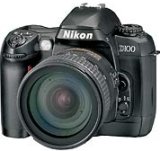
From the top , it looks like this, TOP and from the back it looks like this, BACK
What's more, over at the Advertiser, I now have a friendly contact, Bill, their resident photographer these last twelve years. He's already been very helpful with advice and has invited me to the offices to see how photographs are processed in newspaper production and has offered to talk me through what he knows. I have a fairly good prospect of freelancing for that paper in the future too.
johncoxon 11:56 PM - [Link] - Comments ()
...
TEA : The British National Beverage ?
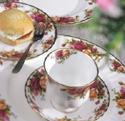
Knowing I'm a proud English 'Brit', you'd be forgiven for expecting me to drop everything at 4 p.m or thereabouts, and take afternoon tea using this sort of table ware. In fact, we don't have a fine bone china tea set, even stored safely away for special occasions, and we don't own, I'm ashamed to say, any ROYAL DOULTON just bits and bobs, and here I 'set the table' with the best I could muster.

Now to be honest, in making this cup of tea in one of the few cups and saucers we have in the house, well, I did have, but didn't use, one of a range of six different tea-pots, we own, to choose from. I cheated. Significantly, I didn't have or need one of these essential traditional tea making tools ; the tea 'strainer.'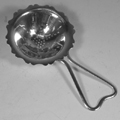
Your true tea drinking English person warms the pot first and then spoons in the dried leaves of 'Camellia Sinensis' the genus of plant to which all real teas belong, before pouring onto the black or green leaves,boiling water. The rule of thumb is one spoon of tea for each person and 'one for the pot' to get the correct tea strength. After a respectful few minutes, when the tea has brewed, (a 'brew' is slang for a cup of tea, hence 'Make me a brew will you ?') the boiling water in your tea pot changes colour, depending on what tea leaves you use, and is enriched with all those healthy, naturally occuring antioxidants, valuable phenolic compounds called flavonoids. ('Stewed' is what tea becomes if you leave it to 'brew' too long.)The 'dregs' ( or Leas) of tea leaves are retained by the 'tea strainer', usually a metal filter through which the brewed tea is poured into the cup from the tea pot( unless of course you are in the presence of one of those mystics who claim to be able to tell your fortune by the pattern of tea leaves left at the bottom of the tea cup when you have finished drinking it.)
Now, appearances can be deceptive as this glimpse of our tea things illustrates.
Now, the blue, nostalgic looking tin, on the right, is from the celebrated traditional London, (Picadilly) Tea company,JACKSONS but we use it, not for tea leaves, but to keep our granulated sugar in. All the the tea pots in our house, to the best of my knowledge, have never been used once to make a pot of tea. They are just things we liked the look of and collected. That authentic red 'Typhoo Teas' tin? That's where we keep our tea airtight. (Ah! Typhoo. I recall their advertisement slogans to this day. "Typhoo puts the 'T' in Britain", and , "You only get an OOh! with Typhoo.") Our tin contains, horror of horrors, not traditional packet tea leaves, as a tea-purist would have asa a must, but, tea bags. (I am a devoted, caffeine addicted coffee drinker and the tea bags are reserved for Angela, who likes her "refreshing cuppa" and some of our visitors.
Tea Facts and a little History
Customs change. According to my research, Brits are novices when it comes to tea drinking which started here a mere 350 years ago, although it has been drunk in Asia for some four thousand years. (Buddha , Sir Isaac Newton and Chinese Emperpor Shen Nung made major discoveries of different sorts under conveniently placed trees.) In 2737 BC , the story goes, when, whilst seated under a tea tree, a leaf fell into some boiling water, Shen Nung decided to drink the brew. All tea drinking, we are asked to believe , stems from this moment.
By 1880 Britain imported a staggering 180 million llbs of tea per year. In 1970 the average Brit consumed 10 llbs of tea a year. So important was tea drinking that, in 1960, the government actually legislated to make it a worker's right to have two 'tea-breaks' each working day! I hear too that by 1988, Britain got though a staggering 162,000 tons of tea a year ! Tea, we are told is the world's mosy popular drink and is still Britain's most popular drink, but consumption has dramatically decreased since its hey day here.
'Milk First Custom'
Some people still put milk in the cup before pouring their tea. This, an urban myth has it, goes back to the time when tea was a rare commodity drunk by the rich in expensive, frail imported porcelain cups. To prevent the valuable crockery cracking from the heat of boiling water, putting the milk in first protected the china from cracking.
Afternoon Tea?
The notion of Brits all stopping whatever they are doing sitting down to gentile afternoon tea is a myth as well, since , at the appointed time, all but the idle rich are still at work. I associate drinking tea from the 'best' crockery, always brought out in some classes, in the 'front room' as something done when you felt the need to impress. Like most busy British people these days, I drink my beverage in a large, sturdy mug and it is only in hotels that I am forced to drink my coffee from tea-cup sized vessels. I also associate tea in delicate cups and saucers with uncomfortable visits to elderly relatives where I was terrified of dropping the cup or spilling the drink in the saucer. Maiden aunts, for exmple, had these delicate things as well and offered you decorated cakes from them which you felt obliged to accept, even if it meant the terror of balancing a plate in one hand and a cup and saucer in the other.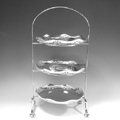
As in the tea ceremony in China, for example, making tea the traditonal way is a calming ritual in itself which, essentially takes time and is therefore associted with relaxing. Not only that, there is this insanely British thing about "putting the kettle on" ( heating water for tea) at moments of crisis, when a nice cup of tea will make everything seem brighter and cure all the world's ills. Read into that , at times when there is little you can do when events take a turn for the worst, someone always offers to make a "nice cup of tea."
And then there is some mysterious language associated with tea in Britain. "Fancy a nice cup of Rosy?" someone asks. What? Rosie Lee=Tea ( London Cockney rhyming slang.") He's a tea leaf." (thief) Tea is still sometimes referred to as 'cha', based on the original Chinese word for tea. "I wouldn't do that for all the tea in China"( curious really because most tea drunk by Brits is Indian tea.)"Who's going to be mother ?" ( Who's going to pour the tea ?) "I'll be mother " (I'll pour the tea) A cup of tea is sometimes referred to as a 'wet'
Changes in drinking habits
Many things have changed in the half century or so I have been around, and notable is the continued myth of the universal tea drinking Brit. Allegedly 70f Brits still drink up to three cups of tea a day , but Coffee enjoys unprecidented popularity here these days,( and coffee was available in Bitain before tea, historically.) Most people I am sure use the quicker and more convenient form of the tea bag as opposed to packet tea now. Many people too drink a variety of herbal and aromatic teas for their alleged health properties and far more people, I think, drink tea without milk as a health thing.
Tea snobs ?
In many places , other than Britain, especially where the official national drink isn't tea, there is, I think , a certian 'snob' appeal in drinking 'English' teas and a healthy international market relies on the myth of gentile English people and their afternoon tea, harping back, too, perhaps to romantic illusions about the British aristocracy. The typical everyday brands that ordinary people drink here are not represented in this market, although, Twinnings, for example do a roaring trade, as does anyone marketing Earl Grey ( Ironic really as it is thought that that blend was given by the Chinese to Earl Grey, originally as a business bribe.)Tea companies trying to halt the decline in tea drinking in general seem to be focussing more and more on the health benefits of various teas, some of which are as yet not effectively proven.
What ever happened to the tea-chest?
One thing I find a curiousity is that you just don't see these useful tea things anymore.
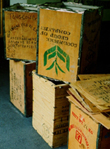
Tea was transported loose, once, in plywood chests like these, lined with tinfoil and edged with tin strips and surprisingly sturdy. Most houses had a few empty ,foil lined large tea-chests for storage somewhere on the premises, and in the old days before sturdy cardboard took over, removal men, who helped you move house, used re-cycled tea-chests to pack and crry smaller items. I haven't seen a tea chest for quite afew years. I guess that is a sign of the times.
Other References:-
TWINNING's TEA(Tea company website with History and related tea facts)
TEA COUNCIL
TEA QUOTES(Quotes on tea from famous people.)
GEORGE ORWELL(the celebrated journalist and essayist's article on Tea)
johncoxon 9:33 PM - [Link] - Comments ()
...
I forgot to include another one of Lowry's paintings called "Bearded Lady"which isn't one of his Northern things but is the result of a visit he made to the south coast at Winchester. Apparently he saw a bearded woman pushing a pram and began sketching her. The lady, we are told, was very unhappy about it and gave him a lot of verbal abuse. Apparently our northern hero was quite shocked to be abused so in gentile Winchester.

The Lowry family originally lived in Longsight near Stockport, but family financial hardship led to them moving to the less affluent Pendlebury in 1909. His father died in 1932 leaving debts and Lowry then had to support his bed-ridden mother. She died in 1939, and it was to his eternal regret that that her death co-incided with the point at which he had gained recognition from the Art world and his mother, sadly would never know that.
It turns out that Lowry lost heart with his family gone and the house fell into disrepair. It was repossessed by the landlord and thus Lowry left 117 Station Road, in 1948. He moved out to Mottram-in-Longdendale, where he spent the rest of his life. He apparently had a collection of clocks there, all telling different times "because he didn't want to know the real time."
A detailed chronology of Lowry's life can be found at TIME LINE
johncoxon 6:13 PM - [Link] - Comments ()
...
A SALFORD STREET
What is the connection between the Windmill Hotel, Pendlebury,(CLICK) 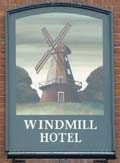
Ghandi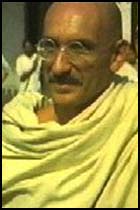
and this internationally celebrated modern Salford waterfront building.(CLICK)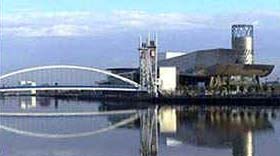
Theanswer is Station Road, an unremarkable Salford street that leads down to Swinton station, from whence it gets its name. Two hundred yards down from the Windmill, at number 119 Station Road, now a local authority Nursing Home, Kenyan born Indian, Dr.Rahimtulla Harji Bhanji had his surgery. His family orginated from the state of Gujarat, where Mahatma Gandhi was born. Dr.Bhanji had a son called Krishna Bhanji who too lived for many years on Station Road. You'll know him better as Ben Kingsley, (now Sir Ben Kingsley) the English actor who won the 1982 Best Actor Oscar in his first major leading role portaying Ghandi. Krishna changed his name on the advice of his father, who thought that an Indian name might hinder his son's career and the stage name was a corruption of his grandfather's nickname in Gujarati, 'Clothes King.'
However, Station Road had another celebrated resident for many years, and, surprisingly, he lived here at number 117 Station Road,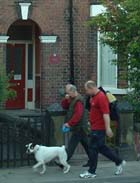
right next door to Ben Kingsley's house. Although this man died in 1976 the City of Salford honoured him, its most famous resident, by naming its most prestigious 21st century waterfront Art Gallery and Theatre complex after him. Click on this small portrait to see our man on Station Road , probably taken in the late forties, early fifties.
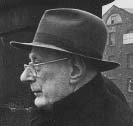
Click here to what the view is like today from the spot where it was taken all those years ago. STATION ROAD TODAY
Our local man is artist L.S.Lowry R.A. ( 1887-1976) and he painted and sketched conventioanlly at many locations near my home. He sketched Newtown Mill Cotton Mill and Bowling Green, which I can see from the rear of my house and this lovely drawing of a barge at nearby Clifton.
Lowry was also a gifted portrait artist as this self portrait (1925) illustrates.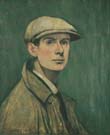
Lowry once remarked,"Painting is my life and art is my religion. I see in painting a battle in which the creation of a work of art becomes a symbol of victory over ignorance, stupidity and superstition. I see art as the language of man's spirit. I believe any divorcing of art from the feeling of humanity is both foolish and dangerous, and that such art can only end in pretty surface patterning, or in a delving into the sub-consciousness of the artist's personality, which often proves a messy and unwholesome business." Lowry's later life was one of isolation and some of his work is often quite bizarre. You are not sure whether they represent a sense of humour or something more disturbing. There are for example, a series of stylised, very strange geometric drawings of little girls with exaggerated bows tied around their necks, and also this strange image from 1938
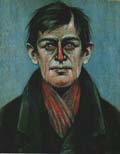
Here is a composite of some images of Lowry, some photographed in his attic studio at 117 Station Road, and others out on the streets in our local area.

But, even though L.S.Lowry was capable of very skilled conventional, realistic art, he chose to represent the world of the industrial north in a unique, innocent, primitive and sometimes humorous yet completely charming way, and it is for these almost 'childlike' detailed painted images that L.S.Lowry is chiefly remembered.
As well as these almost childlike but so evocative street scenes, many of Lowry's painting depict industrial landscape scenes, similar to those which might have been seen near that cotton mill, so near my home and his.
Finally, Lowry had a sensitivity to the poverty and pathos of working class life on the streets of Salford and industrial hard knocks Northern England, as illustrated here with his "Fever Van" painting, where the whole community seem concerned that one of their own is being carried away by an ambulance.
johncoxon 12:47 AM - [Link] - Comments ()
...